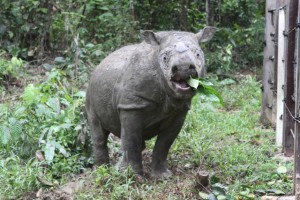
By Daily Express – February 10, 2011
Kota Kinabalu: Sabah is open to all genetic resource banking reproductive possibilities with German and American help as a “desperate measure in desperate times” to save its last Sumatran rhinos from extinction.
State Wildlife Director Dr Laurentius Ambu told a gathering of top world rhino propagation experts at the Sumatran Rhinoceros Global Management and Propagation Board (GMPB) dinner Tuesday night at Rasa Ria Resort, Tuaran: “I think we can all agree, that giving up is not an option.”
Dr Ambu said near complete failures in past captive breeding programmes here and in Indonesia makes it clear that Sabah needs to “do some new things.” The largely failed captive propagation efforts is evident from such statistics that of the 43 Sumatran rhinos brought into captive conditions from the wild between 1984 and 2008 (Sabah and Indonesia combined), only one pair produced offsprings (and in Cincinnati Zoo of all places).
The bad news is that while there are no recent Sumatran rhino births in captive conditions, populations in the wild appear to continue to decline, or at best not increase, despite best efforts at protecting the habitat as well as the rhinos.
Ambu said at least two measures have to be considered. “One is to boost the genetic diversity by capturing a few more wild rhinos and then try to raise the prospects for successful natural breeding in captive populations. “We are pursuing this option in Sabah and since April 2010 we have been targeting to capture a specific young female rhino from the wild,” he said.
The second is to pursue artificial insemination. This is where German expertise from the Institute for Zoo and Wildlife Research, Berlin, is coming in to assist through “an attempt to induce ovulation in captive females named Gelogob through hormone treatment” – an option Sabah is not doing currently because Gelogob is past its normal reproductive age.
“This time, Sabah is getting into a must-genetic resource banking, on top of doing our best to get more births of Sumatran rhinos in captive conditions,” Dr Ambu pointed out.
“This means we’ll be doing cryo-preservation of semen, oocytes, ovarian tissue and embryos,” Ambu explained.
“By doing that, the prospect remains open that the species can be saved from extinction, whatever happens in the next few years in terms of success or failure with natural or assisted breeding,” Ambu added.
Prof. Heribert Hofer said he is “optimistic” for the Sumatran rhino, citing the Indian rhino which once fell to single digit in numbers but has been raised up to “thousands” now.
“The good news is despite all the continuing odds against the Sumatran rhino, the species stubbornly refuses to go extinct,” he noted.
“There are still Sumatran rhinos in the same protected areas which were their strongholds in 1995, such as Indonesia’s Bukit Barisan Selatan, Way Kambas, Gunung Leuser and Sabah’s Danum Valley and Tabin Wildlife Reserve,” Ambu added.
“The other good news is we can confirm that the Sumatran and Borneo forms of the rhino are genetically close. We may be confident that mixing the two for breeding does have scientific backing.
“It remains only for agreement at the policy level to allow us to proceed.”
The rhino global captive propagation programme has probably lost two precious decades due to bad collaboration.
It was initiated at a landmark IUCN-led meeting 26 years ago in 1984 in Singapore, represented by Sabah, Malaysia, Indonesia, USA, UK, governments and NGOs who agreed that conservation of the Sumatran Rhino should be prioritised.
In the same year, the global captive breeding programme involving Indonesia, Malaysia, USA and United Kingdom, was launched but the different partners went their own ways and collaboration was not ideal. But judging by the convergence of a throng of the best German, American, British, Malaysian and Indonesian experts at the GMPB meeting at Rasa Ria to work out the best last ditch propagation measures, “desperate times” seems to be healing the broken collaboration.
The Sumatran rhinoceros once inhabited rainforests, swamps and cloud forests in India, Bhutan, Bangladesh, Myanmar, Laos, Thailand, Malaysia, Indonesia and China, but now they are critically endangered, with only six substantial populations in the wild – four in Sumatra, one in Borneo and another in Peninsular Malaysia.
The experts present include Dr Susie Ellis, executive director of International Rhino Foundation, Dr Heribert Hofer, Director of Leibnitz Institute for Zoo and Wildlife Research which focuses on “complicated species” such as the rhino, Dr Terri Roth, Director of Cincinnati Zoo’s Center for Conservation & Research for Endangered Wildlife (CREW) which distinguished itself for successfully reproducing the first Sumatran Rhino calf in captivity in 2001, Dr Nan Schaffer of SOS Rhino, Widodo Ramono, chairman of GMPB cum executive director of the Indonesia’s Rhino Foundation, Dr Arun Ventakaraman of WWF-Malaysia, Datuk Dr Junaidi Payne, executive director of Bora and others.
Datuk Ellron Angin, Assistant Minister of Culture, Tourism and Environment represented his Minister, Datuk Masidi Manjun.